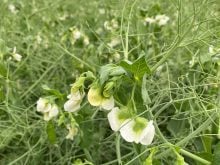Although many people believe the environment is getting steadily worse, small projects on local rivers and farms show environmental damage can be not only minimized, but reversed.
The result can be seen in walleye that swim in the river that runs through a feedlot in western Manitoba.
“It’s nice to see fish back up at that farm that haven’t been there for 100 years,” said Manitoba Water Stewardship department official Martin Erickson during the Living With Livestock conference in Winnipeg.
A project overseen by Erickson has helped farmers, landowners and people along the Little Saskatchewan River system reduce nutrients flowing into the water, something he said cattle producers happily embraced.
Read Also

Crop quality looks good this year across Prairies
Crop quality looks real good this year, with the exception of durum.
Riverbanks and other riparian areas have been protected and dams along the river have been modified to allow fish to travel up and down the system.
As well, studies on California farms have shown that simple and cheap riverbank protection can drastically reduce the amount of bacteria that cattle manure passes on when water flows toward a river.
By fencing off a few metres of riverbank, cryptosporidium parvum, which causes severe scours in calves and can infect humans, was reduced 99.9 percent, said Edward Atwill of the University of California’s veterinary school.
Riverbank buffers are a cheap and effective means of cleaning up farmland runoff. This is good news for farmers wanting to reduce disease counts in their water supply and for municipalities cracking down on agricultural pollution.
“Common sense stuff is pretty darned easy to implement,” Atwill said in an interview.
“Keep an eye on where your animals are, where your manure is and try to get at least a minimal buffer width to deal with it.”
Cryptosporidium parvum takes a toll on calves. The microbial infection attacks a calf’s digestive system, produces millions of eggs and is shed through diarrhea.
The disease, like most infectious diseases, will die if manure is allowed to break down slowly. However, it can spread rapidly if manure quickly gets into water sources.
Dairy barns suffer most because the animals are kept close together and moisture is always present. However, beef herds suffer as well when infected manure is allowed to collect and is swept into water sources.
Simply fencing off a few metres, perhaps as few as three and allowing grass and natural plants to re-establish themselves along the edge of a river, create an effective filter, Atwill said.
“If it’s real luxurious growth, you can probably get pretty darned close (to the river),” he said.
“As long as it’s been treated well and it’s real thick cover, and the soil is not overly compacted, they’re good kidneys.”
Atwill said farmers may find that the sacrifice of a few metres of riparian area is a cheap way to keep out of trouble with downstream water users.
“It won’t be too expensive,” he said. “That’s probably all that anyone would want to see done. That might just be enough.”
Erickson said producers along the Little Saskatchewan gladly participated in the water improvement project, which was partly funded by governments and other agencies but also included the producers’ own money.
Fencing was all that most cow-calf producers had to build, Erickson said, but the feedlot operator, whose third-generation operation was located right beside the river, had to move a shelter and some pens.
The riverbank and a strip of land were allowed to recover and green up, which occurred within two years.
It took a lot of work and money, but after it was done, nutrient counts in water flowing off his feedlot dropped to almost nothing.
“It was nice to see that,” he said.
“It was quite a dramatic improvement.”
Erickson, like other producers, was willing to do the work because it was a local project that involved neighbours working together. There were few conflicts.
“These guys live in the same area and they want to make things better.”

















